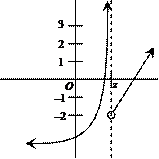|
Honors AP Calculus / Mr. Hansen |
Name: _______________________________________ |
|
9/18/2006 |
Mr. Hansens use only (bonus point for spare
batteries): _______ |
Test on Chapter 1 and Class Discussion
Please read:
Calculator is OK throughout. Problems
#1, #2, and #25 are 6 points each; all others except #19 are 4 points each. Important: For multiple-choice questions
(#3-24), mark answers only on the
bubble sheet, not here. Multiple-choice scoring is as follows: 4 points if
answer is correct, 0 points if blank, 1 point if
wrong.
|
1. |
Let v(t) be a continuous velocity function, and let h(t)
denote the height of a particle at time t.
If h(3) is
given to be 3.6 m above ground, find h(4).
Hint: Use FTC1. |
|
||||
|
|
|
|
||||
|
|
|
|
||||
|
|
|
|
||||
|
|
|
|
||||
|
|
|
|
||||
|
|
|
|
||||
|
2. |
State FTC1 and FTC2.
Labeling does not matter, since textbooks differ on which is called which. |
|
||||
|
|
|
|
||||
|
|
|
|
||||
|
|
|
|
||||
|
|
|
|
||||
|
|
|
|
||||
|
|
|
|
||||
|
3. |
Which of the following is
an example of a calculus? |
|
||||
|
|
(A) statistics |
(D) navigation |
|
|||
|
|
|
|
||||
|
4. |
Categorize the following: |
|
||||
|
|
(A) first-order ODE |
(D) second-order PDE |
|
|||
|
|
|
|
||||
|
5. |
A function f for which the function f ¢ can be found for each point in Df is said to be . . . |
|
||||
|
|
(A) in
closed form |
(D) derivitable |
|
|||
|
|
|
|
||||
|
6. |
The trapezoid rule
approximation for |
|
||||
|
|
(A) 77.492 |
(D) 77.558 |
|
|||
|
|
|
|
||||
|
7. |
The correct answer to #6 is
. . . |
|
||||
|
|
|
|
||||
|
8. |
An accumulator function is
. . . |
|
||||
|
|
(A) any linear function |
|
||||
|
|
|
|
||||
|
9. |
An initial condition for a
differential equation is a clue consisting of . . . |
|
||||
|
|
(A) an ordered pair (often)
that allows us to select a particular solution from among all possible
general solutions |
|
||||
|
|
|
|
||||
|
|
In problems 10 through 12,
the functions s(t), v(t), and a(t)
are to be interpreted as position, velocity, and acceleration at time t, respectively. |
|
||||
|
|
|
|
||||
|
10. |
|
|
||||
|
|
(A) 0 |
(D) 4.422 |
|
|||
|
|
|
|
||||
|
11. |
If s(t) is defined as in
#10, then v(3) is . . . |
|
||||
|
|
(A) 0 |
(D) 2.449 |
|
|||
|
|
|
|
||||
|
12. |
For any particle, not
necessarily the particle whose position was defined in #10, the expression |
|
||||
|
|
(A) change in position
(i.e., Ds) from t = 0 to t = 4 |
(D) v(4) |
|
|||
|
|
|
|
||||
|
13. |
If f (x) = |x|, then f ¢(0) is . . . |
|
||||
|
|
(A) 0 |
(D) ±1 |
|
|||
|
|
|
|
||||
|
14. |
For a continuous function y = f (x), a cusp is a point (x, y) such that . . . |
|
||||
|
|
(A) f ¢ is a continuous function on Df |
(D) f has a vertical asymptote at x |
|
|||
|
|
|
|
||||
|
15. |
Given: |
|
||||
|
|
(A) a general solution |
(D) a value for
y and a value for y¢ corresponding to any desired value of x Î Df (E) both (B) and (D) |
|
|||
|
|
|
|
||||
|
16. |
Any continuous function f has . . . |
|
||||
|
|
(A) a unique antiderivative |
(D) both (A) and (C) |
|
|||
|
|
|
|
||||
|
17. |
For which function f do both f ¢ and f ¢¢ appear to be positive on all of Â? |
|
||||
|
|
|
|
|
|||
|
|
|
|
|
|||
|
|
|
|
|
|||
|
|
|
|
|
|||
|
|
|
|
|
|||
|
|
|
|
||||
|
18. |
For the function G(x)
= sin2 x + 3 cos2
x, the instantaneous rate of change
when x = 1 is . . . |
|
||||
|
|
(A) 1.818 |
(D) 1.819 |
|
|||
|
|
|
|
||||
|
19. |
On the AP exam, there are 4
graphing calculator features that you may use without having to show work, in
addition to the obvious operations of arithmetic and function evaluation.
They are . . . |
|
||||
|
(2 pts., no penalty for
guess) |
(A) MATH 8, MATH 9, MATH 0,
and anything on the 2nd CALC menu |
|
||||
|
|
|
|
||||
|
20. |
Are both x3 and x3 + 1 valid antiderivative
functions for the function y = 3x2? |
|
||||
|
|
(A) No, because the first
one is lacking a constant term. |
|
||||
|
|
|
|
||||
|
21. |
Let a function be defined
piecewise as |
|
||||
|
|
|
|
|
|
||
|
|
|
|
|
|||
|
|
|
|
|
|
||
|
|
|
|
||||
|
22. |
Recall that the notation x ® 3 means as x approaches 3 from below (i.e., from the left). |
|
||||
|
|
(A) 0 |
(D) 9 |
|
|||
|
|
|
|
||||
|
23. |
For the function defined in
#22, |
|
||||
|
|
(A) 0 |
(D) 9 |
|
|||
|
|
|
|
||||
|
24. |
The function defined in #22
has . . . |
|
||||
|
|
(A) a vertical asymptote at
x = 3 |
(C) no discontinuity
anywhere (i.e., f is continuous on Â) |
||||
|
|
|
|
||||
|
25. |
|
For the function f sketched at left, write the limit of
f (x) as x approaches z from below, from above, and as a
2-sided limit. Write 3 equations or statements using proper lim notation. Your notation will be graded as well as
your answers. |
||||
|
|
|
|||||
|
|
BONUS
SECTION (½ pt. each) |
|||||
|
|
|
|||||
|
B1. |
Choose an answer, A through
E. Hint: Choice D is not correct. |
|||||
|
|
(A) |
|||||
|
|
|
|||||
|
B2. |
What is the only movie that
Mr. Hansen has seen in a theater during calendar year 2006? Hint: Choice D is not correct. |
|||||
|
|
(A) An Inconvenient Truth |
|||||
|
|
|
|||||
|
B3. |
Choose an answer, A through
E. Hint: Choice D is not correct. |
|||||
|
|
(A) |
|||||
|
|
|
|||||
|
B4. |
Which of the following
sentences is correct in grammar and punctuation? Hint: Choice D is not correct. |
|||||
|
|
(A) The problem is that
nobody has responded yet. |
|||||
|
|
|
|||||
|
B5. |
What 2-letter word do we
try never to use in the calculus? _______ Hint:
The word does not appear anywhere in todays test. |
|||||













